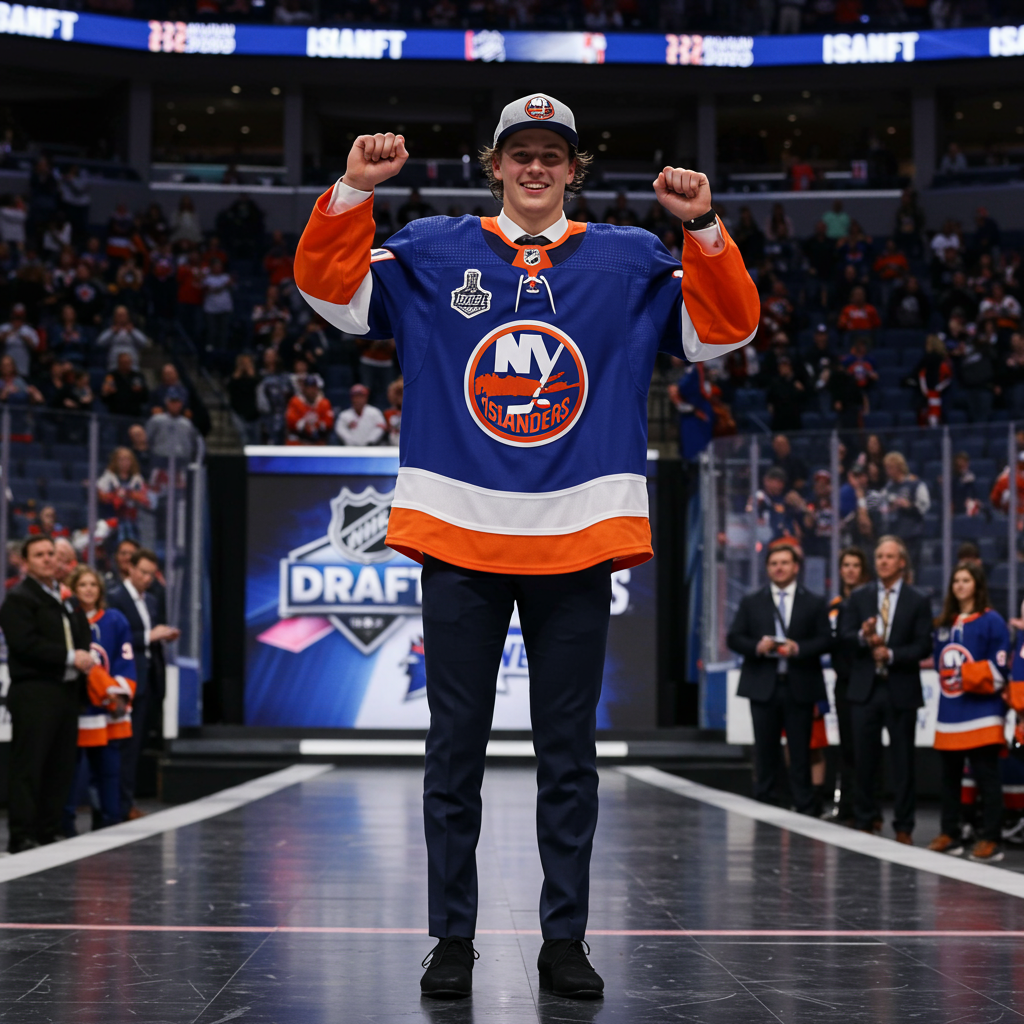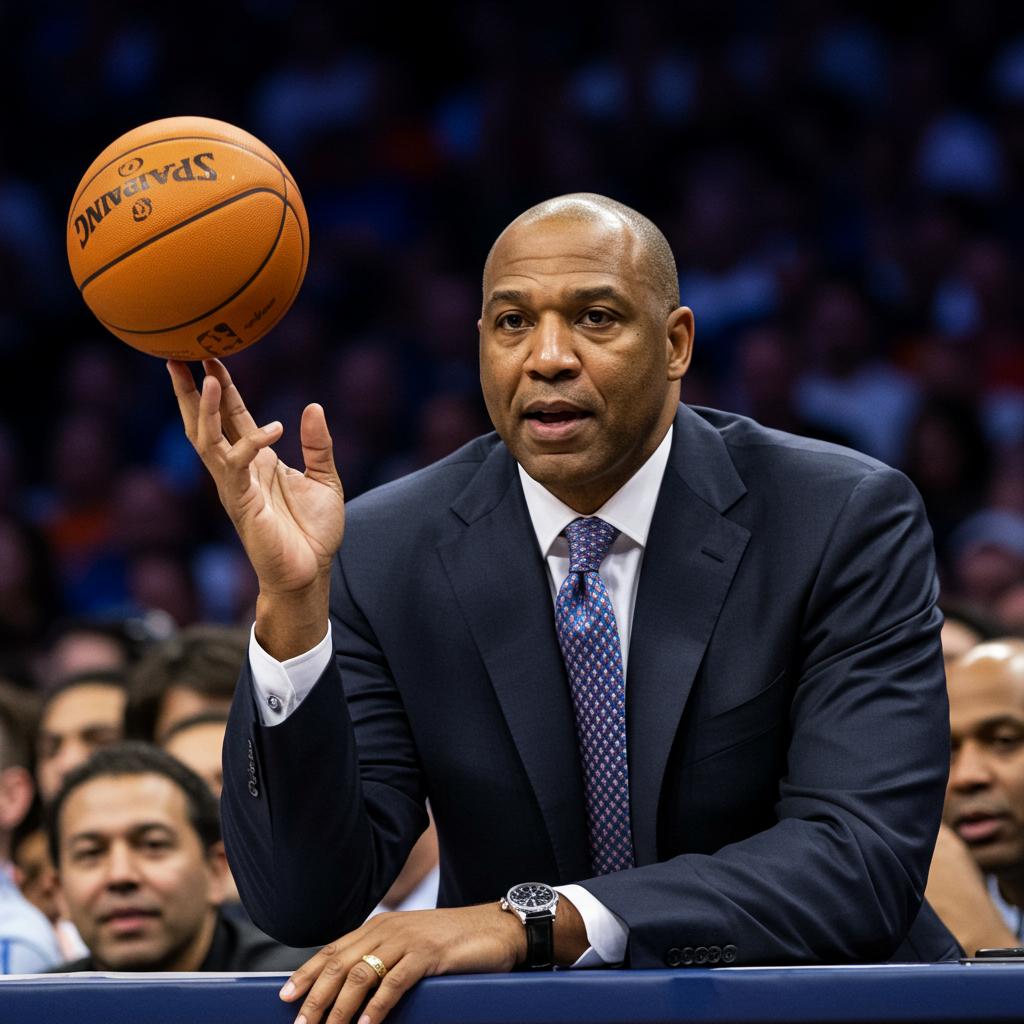The 2025 NHL Entry Draft’s first round unfolded with anticipation in Los Angeles, culminating in the New York Islanders selecting defenseman Matthew Schaefer first overall. After a surprising leap from 10th place to claim the top pick via the draft lottery, the Islanders solidified their future on the blue line with the highly-touted prospect from the Erie Otters. The night was filled with significant trades, surprising selections, and in-depth scouting reports on the next generation of hockey stars. Experts weighed in on every pick, evaluating talent, fit, and potential value, offering unique insights into how teams approached building their rosters.
Islanders Make Schaefer the Cornerstone
The biggest news of the night was undoubtedly the New York Islanders‘ selection of Matthew Schaefer at No. 1. Schaefer, a defenseman from the Erie Otters, was widely considered the consensus top prospect despite battling injuries, including mono and a broken clavicle that ended his season prematurely. Standing at 6-foot-2, 186 pounds, Schaefer is lauded for his exceptional skating ability and elite hockey IQ. Scouts highlighted his prowess in moving the puck out of the defensive zone, with one specifically calling him an “exit machine.” His ability to control play and his tremendous compete level were also key factors in his top ranking.
According to analysis from multiple experts, Schaefer possesses game-breaking skill and decision-making that make him a potential cornerstone defenseman. Despite the pressure on the Islanders to potentially select local talent like James Hagens, they opted for Schaefer, who was deemed the best player available. His projection is that of a top-pairing, two-way defenseman and power-play quarterback, drawing comparisons to NHL star Josh Morrissey. His emotional reaction to being drafted, mentioning his late mother, added a poignant moment to the evening.
Islanders Busy Before and During Draft
The Islanders’ draft night activities weren’t limited to the first pick. General Manager Mathieu Darche made a significant trade before the draft began, sending defenseman Noah Dobson to Montreal for forward Emil Heineman and the Canadiens’ two first-round selections. This trade dramatically altered the Islanders’ first-round strategy.
With Montreal’s acquired picks, the Islanders added more talent. At 16th overall, they selected Victor Eklund, a winger from Djurgarden IF. Eklund is described as an aggressive, speedy, and skilled winger with historically high production for a U19 player in Sweden’s Allsvenskan league. Seen by some as a potential draft steal, he’s a “buzzsaw” who gives an honest effort and leverages quickness and skill. Peters graded this pick highly, comparing Eklund’s style to Seth Jarvis.
Just one pick later, at 17th overall, New York drafted defenseman Kashawn Aitcheson from the Barrie Colts. Aitcheson is known for being one of the draft’s most physical players, bringing a nasty edge to the defensive zone. While initially seen primarily as a physical blueliner, he “exploded offensively” this season, nearly hitting a point per game. Aitcheson is described as a “gamer” who loves joining the rush and can play both a competitive, physical style and an active, offensive one. Peters viewed the Islanders’ overall haul from the Dobson trade, landing Schaefer, Eklund, and Aitcheson, as an “absolute haul” adding two potential top-four defensemen and a high-end winger.
Top Forward Prospects Join New Teams
After Schaefer, the draft saw a run on highly skilled centers and wingers, with teams addressing critical needs up front.
At No. 2, the San Jose Sharks selected center Michael Misa from the Saginaw Spirit. An exceptional status player in the OHL, Misa was the CHL’s leading scorer despite a playoff injury. He’s praised for being intelligent and tactical, reading plays, exploiting defensive holes, and creating advantages. Misa is seen as the “smartest player available” and the best forward in terms of pure skill, with elite skating, vision, and playmaking. Peters and Pronman both graded this pick A-, seeing Misa as a “star No. 1 center” and a perfect fit for the Sharks’ young forward core, including Macklin Celebrini and Will Smith. He’s projected to be the team’s long-term No. 2 center.
The Chicago Blackhawks, picking third, chose center Anton Frondell from Djurgarden IF. Frondell had historically high production for a U18 player in Sweden’s second league. He’s a powerful center with an excellent shot, committed to two-way play and physicality. While Pronman graded this pick lower (B-) due to higher-ranked players available, Peters noted Frondell provides needed size (nearly 6-foot-2), strength, and a powerful shot, projecting as a top-six player with strong two-way potential, a potential strong second-line center behind Connor Bedard.
Making their debut draft pick, the Utah Mammoth selected center Caleb Desnoyers from the Moncton Wildcats at No. 4. Desnoyers was often described as the most complete player in the draft. He’s a smart, tenacious, and energetic 200-foot player who receives significant ice time in all situations. Praised for his exceptional hockey IQ, vision, and edgework, his high offensive production (84 points in 56 games) relies on creation rather than exploiting mistakes. Both Pronman and Peters graded this pick A-, seeing him as an ideal fit for Utah’s need for a reliable No. 2 center behind Logan Cooley.
The Nashville Predators took center Brady Martin from the Soo Greyhounds at No. 5. Martin is known for his super intense, “take-no-prisoners” style and being perhaps the draft’s most feared body checker, bringing physicality developed on his family farm. He also scores well (33 goals, 72 points) and played a massive role for Canada’s U18 gold medal team. Pronman graded this pick C+, while Peters, who ranked Martin lower, understood the appeal of his constant energy, physical game, leadership potential, and character in today’s NHL. He projects as a No. 2 center or top-six wing.
Picking sixth, the Philadelphia Flyers selected right wing Porter Martone from the Brampton Steelheads. Martone is a large (6-foot-3) power forward with soft hands and tremendous offensive potential. He can score in various ways and is hard to move from the net front. While Pronman gave him an A+ grade for potential value, he noted concerns about consistency and needing to improve his work ethic. Peters noted the Flyers reportedly wanted a center but took Martone, adding size and skill to their forward group.
The Boston Bruins drafted center James Hagens from Boston College at No. 7. While some scouts projected him higher, Hagens fell slightly after a perceived “slightly underwhelming” offensive year in the NCAA against tougher competition. However, he’s highly praised for his elite playmaking, exceptional hockey sense, vision, and ability to make plays at pace. Pronman and Stuart both gave him an A grade, seeing him as a great value pick for the Bruins’ rebuild, adding a dynamic offensive catalyst.
At No. 8, the Seattle Kraken chose center Jake O’Brien from the Brantford Bulldogs. O’Brien is highlighted for his phenomenal playmaking, passing, vision, and hockey sense. He had 98 points in the OHL, showcasing decisiveness and a good nose for the net (32 goals). Also noted for strong defensive responsibility and work ethic, he projects as a credible No. 2 center. Peters saw this pick continuing Seattle’s trend of drafting centers, adding significant skill and creativity.
Defensemen and Goalies Also Feature Early
While forward talent dominated the early part of the first round, several highly-regarded defensemen and even goaltenders also heard their names called.
The Buffalo Sabres, needing a right-shot defenseman, selected Radim Mrtka from the Seattle Thunderbirds at No. 9. Mrtka is a massive 6-foot-6 blueliner with superior mobility and puck-moving capabilities for his size. His ceiling is seen as limitless, though concerns exist about his lack of consistent physicality. Peters graded him C+, viewing him as a project with incredible potential to be a top-four defenseman, adding size and balance to Buffalo’s blue line.
Other defensemen taken in the first round included Jackson Smith (Tri-City Americans) by the Columbus Blue Jackets at No. 14, praised for his athletic profile, strong skating, and defensive know-how; Kashawn Aitcheson (Barrie Colts) by the New York Islanders at No. 17 (discussed above); Cameron Reid (Kitchener Rangers) by the Nashville Predators at No. 21 (acquired via trade), seen as a significant riser with good skating, hockey sense, and puck-moving ability; Logan Hensler (University of Wisconsin) by the Ottawa Senators at No. 23 (acquired via trade), noted as a mobile, right-shot defender with defensive know-how; Sascha Boumedienne (Boston University) by the Winnipeg Jets at No. 28, recognized as one of the draft’s best skating defensemen with excellent mobility; and Henry Brzustewicz (London Knights) by the Los Angeles Kings at No. 31 (acquired via trade), who moves well and defends solidly. The draft showcased a variety of defensive types, from shutdown physicality to dynamic puck-movers.
Goalies also made an appearance in the first round. The Columbus Blue Jackets selected Pyotr Andreyanov from Krasnaya Armiya Moscow Jr. at No. 20. Andreyanov posted spectacular numbers in Russia’s top U20 league and grew to 6-foot-2. He’s described as a quick, athletic goalie who reads the game well, though Peters admitted less familiarity with him compared to others, noting Andreyanov became a late hot name among team personnel. Pronman graded this pick C, noting concerns about his size (6’0″ listed by Pronman) and agility despite impressive numbers.
The second goalie off the board was Joshua Ravensbergen from the Prince George Cougars, taken by the San Jose Sharks at No. 30. Ravensbergen was the consensus top goalie by many (including B/R and FloHockey) despite inconsistent numbers. He possesses impressive physical tools, size (nearly 6-foot-5), calmness, and athleticism. Peters argued taking a chance on his potential No. 1 goalie ceiling was worthwhile late in the first round. Pronman graded this pick A-, praising his quickness and sense combined with size.
Trades and Notable News Items
The first round was punctuated by several significant trades beyond the Islanders’ Dobson deal. The Pittsburgh Penguins were particularly active, trading their No. 12 pick to the Philadelphia Flyers for picks No. 22 and 31. Later, the Los Angeles Kings traded their No. 24 pick to the Pittsburgh Penguins for picks No. 31 and 59, meaning Pittsburgh ended up trading down twice to accumulate assets while still making three first-round selections (11, 22, 24). Other trades included the Ottawa Senators sending pick No. 21 to the Nashville Predators for picks No. 23 and 67, and the Carolina Hurricanes trading No. 29 to the Chicago Blackhawks for picks No. 34, 61, and a 2027 fifth-rounder.
Beyond the draft floor, Dallas Stars GM Jim Nill was named GM of the Year for the third consecutive year. The NHL and NHLPA also reportedly reached an agreement on a new Collective Bargaining Agreement, which is rumored to end the option for eight-year contracts. Earlier in the day, notable contract extensions were signed by Sam Bennett (Panthers), John Tavares (Maple Leafs), and Trent Frederic (Oilers). Columbus also made a trade before the draft, acquiring Charlie Coyle and Miles Wood from the Avalanche for Gavin Brindley, a 2025 third-rounder, and a conditional 2027 second-rounder.
The draft itself featured a decentralized format, with team officials operating from their home cities while prospects, media, and league officials were in Los Angeles. Deputy commissioner Bill Daly noted the vote for decentralization passed 26-6 among teams. The draft included mentions of prospects with notable NHL bloodlines, such as Will Horcoff (son of Shawn Horcoff), Victor Eklund (brother of William Eklund), and others related to former NHL players and Olympians.
Unique Prospect Profiles and Potential
The first round also highlighted players with intriguing profiles and potential long-term outcomes.
Roger McQueen (Anaheim Ducks, 10th overall) was a massive forward (6-foot-5) with exceptional skill for his size, considered a potential top-three pick before a significant back injury. The injury created a high-risk, high-reward scenario, but Anaheim’s forward depth allowed them to take the gamble.
Benjamin Kindel (Pittsburgh Penguins, 11th overall, later traded pick) was seen as one of the draft’s biggest surprises. Peters ranked him much lower, calling it a “big shock.” Kindel is a smart, crafty winger with high-end hockey sense but needs significant physical development.
Jack Nesbitt (Philadelphia Flyers, 12th overall) was another pick noted as potentially “off the board.” A large (6-foot-4) center, his game is still raw with questions about his skating, but he has power forward potential. Stuart gave this pick a D+ grade, calling it a high price for a project.
Will Horcoff (Pittsburgh Penguins, 24th overall) saw his stock rise significantly. He’s a massive, strong forward committed to two-way play, likely projecting as a role player in the NHL, though some felt the Penguins could have selected higher-end talent.
Václav Nestrašil (Chicago Blackhawks, 25th overall) is nearly 6-foot-6 with outstanding skill for his size and high upside as a middle-six scoring winger, though he needs to improve his pace. Chicago specifically targeted size with their later first-round picks.
Ryker Lee (Nashville Predators, 26th overall) was the USHL’s rookie of the year, a high-end skill player who needs strength and skating work, adding dynamic potential to Nashville.
Lynden Lakovic (Washington Capitals, 27th overall) is a 6-foot-4 power winger with good hands and skill. Peters saw great value in finding a player with his size and hands this late, fitting Washington’s talented wingers.
Mason West (Chicago Blackhawks, 29th overall) was perhaps the most fascinating pick. A 6-foot-6, 220-pound high school athlete committed to playing football in college before potentially returning to hockey. Peters called it a “gigantic swing” with high upside but much unknown due to his recent realization of NHL potential and dual-sport commitment.
The first round concluded with a mix of high-skill, high-pace players and those with notable physical dimensions, offering a diverse set of potential future NHLers for the league’s 32 teams.
Frequently Asked Questions
What were the key trades that happened during the first round?
The first round saw significant movement. The New York Islanders traded defenseman Noah Dobson to Montreal for forward Emil Heineman and Montreal’s two first-round picks (16th and 17th overall). Pittsburgh made two trades to move down, sending pick 12 to Philadelphia for picks 22 and 31, and trading pick 24 to Los Angeles for picks 31 and 59. Ottawa traded pick 21 to Nashville for picks 23 and 67. Carolina traded pick 29 to Chicago for picks 34, 61, and a 2027 fifth-rounder.
Who were considered the top goaltenders drafted in the first round, and what are their strengths?
Two goaltenders were selected in the first round. Pyotr Andreyanov was picked 20th overall by the Columbus Blue Jackets. He’s described as a quick, athletic goalie with impressive numbers in Russia’s U20 league. Joshua Ravensbergen was taken 30th overall by the San Jose Sharks. Considered by many as the consensus top goalie available, he has excellent physical tools, size (nearly 6-foot-5), calmness, and athleticism, despite inconsistent performance data.
What were some notable surprises or reaches in the first round, according to experts?
Experts highlighted a few surprising selections relative to pre-draft rankings. Benjamin Kindel going 11th overall to Pittsburgh was called a “big shock” by one analyst. Jack Nesbitt at 12th overall to Philadelphia was noted as potentially “off the board” given his raw game and skating concerns. The selection of Pyotr Andreyanov at 20th overall was also seen as a reach by some, although team personnel reportedly highly rated him. Mason West at 29th overall was considered a “gigantic swing” due to his dual-sport commitment and limited high-level hockey experience.
Conclusion
The first round of the 2025 NHL Entry Draft delivered excitement, saw impact trades, and introduced a promising class of future NHL talent. Matthew Schaefer emerged as the undisputed first overall selection, solidifying the Islanders’ defense. The depth of high-skill forwards and intriguing defensive and goaltending prospects ensures that teams across the league added significant pieces to their organizational pipelines. As these young players embark on their development journeys, the 2025 draft class sets the stage for future stars to emerge and impact the NHL landscape for years to come. The remaining rounds on Saturday will provide further depth and potential steals as teams continue to build for the future.
Word Count Check: 1560



